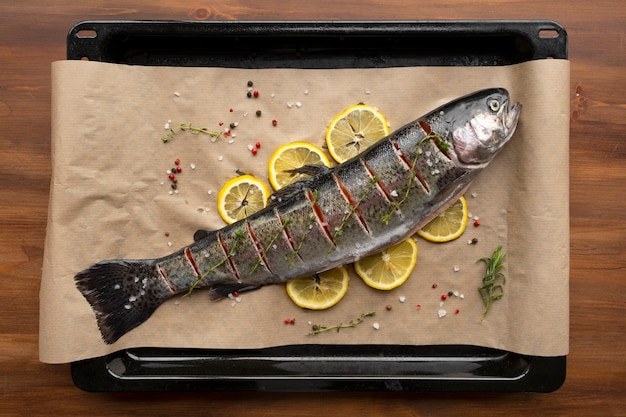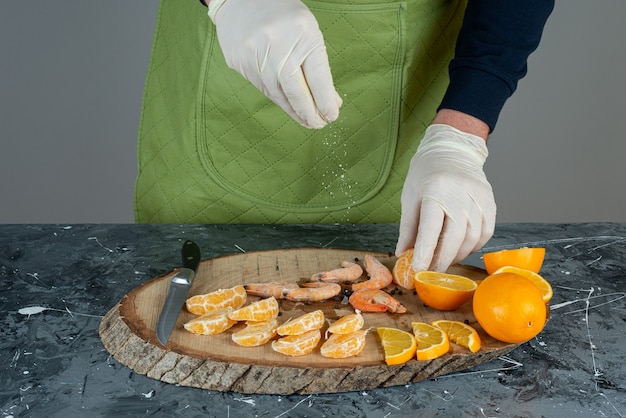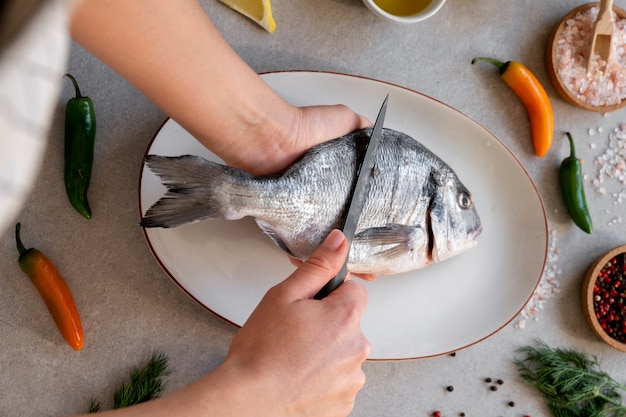Let's be honest, there's nothing quite like the aroma of freshly baked fish filling your kitchen. It's one of those smells that instantly makes you feel relaxed and ready for a delicious meal. But, getting that perfect, flaky, and juicy fish isn't always a walk in the park.
Over the years, I've had my fair share of both triumphs and disasters in the oven baking department. From dry, overcooked fillets to mushy, undercooked disasters, I've learned a thing or two about mastering this simple yet satisfying cooking method.
This guide is your roadmap to oven-baked fish perfection. It's packed with tips, tricks, and a handy cooking time table to ensure your next fish dinner is a complete success. We'll delve into the different types of fish that are best suited for baking, the importance of proper preparation, and the crucial details of temperature and cooking time. Finally, we'll explore some delicious finishing touches and answer frequently asked questions.
(Part 1) Fishy Fundamentals: Choosing the Right Fish

The first step to oven-baked fish glory is choosing the right fish. Not all fish are created equal, and some are better suited to oven baking than others.
Understanding Fish Types
Fillets: These are individual slices of fish, perfect for a quick and easy meal. They're often boneless and skinless, making them ideal for beginners. Think of a cod fillet - easy to handle and cooks up beautifully.
Whole Fish: These are fish that are cooked whole, often with the head and tail intact. They offer a more robust flavour and can be impressive for a dinner party. Imagine a whole sea bass, roasted to perfection, with crispy skin and tender flesh.
Fish Steaks: These are thicker cuts of fish, usually taken from the larger, meatier sections. They're perfect for grilling, pan-frying, or baking. Think of a thick halibut steak, perfect for baking to a golden-brown.
My Favourite Fish for Baking
Over the years, I've come to favour certain fish for their texture, flavour, and ease of baking. Here's a rundown of my favourites, along with the reasons why I think they're perfect for the oven.
- Cod: A classic choice, cod is mild-flavoured, flakes beautifully, and cooks quickly. It's a great option for beginners, especially when you're looking for a light and delicate fish.
- Salmon: Rich in omega-3 fatty acids and bursting with flavour, salmon is a delicious and healthy choice. It has a wonderful oily richness that becomes even more pronounced when baked.
- Sea Bass: A firm, delicate fish with a slightly sweet flavour. It's perfect for baking whole or in fillets. The skin crisps up beautifully in the oven, and the flesh cooks to a tender, flaky perfection.
- Haddock: Similar to cod, haddock is flaky, moist, and cooks quickly. It's another great option for beginners. It has a slightly sweeter flavour than cod, making it a delicious choice for any occasion.
- Halibut: A firm, meaty fish with a rich flavour. It's perfect for baking in steaks or large fillets. It's a robust fish that holds up well to baking, and it's a great choice for a more substantial meal.
(Part 2) Prepping for Perfection: Getting Your Fish Ready

Once you've chosen your fish, it's time to prep it for baking. This step is crucial for achieving that perfect texture and flavour.
Pat It Dry: A Simple Yet Crucial Step
Before you even think about seasoning or marinating, pat the fish dry with paper towels. This ensures that the fish browns beautifully in the oven and doesn't steam, which can result in a soggy texture. Moisture on the surface can create steam, which traps heat and prevents the fish from browning properly.
Seasoning Strategies: Finding Your Fish Flavour
Now comes the fun part: seasoning your fish. I love experimenting with different herbs and spices, but here are a few classic combinations to get you started:
- Simple Salt and Pepper: A classic for a reason, a simple sprinkle of salt and pepper brings out the natural flavour of the fish. It's a great starting point for beginners and allows the fish to shine.
- Mediterranean Flair: Combine lemon zest, garlic, oregano, and a pinch of red pepper flakes for a burst of Mediterranean flavour. This combination adds a bright and tangy flavour to your fish.
- Herby Delight: Chopped fresh herbs like dill, parsley, thyme, or chives add a fragrant touch to your fish. You can use a mixture of herbs or focus on one or two for a more pronounced flavour.
- Spicy Kick: For a bit of heat, add a sprinkle of cayenne pepper, paprika, or chipotle powder to your seasoning mix. These spices add a layer of complexity and depth to the flavour of your fish.
(Part 3) The Baking Basics: Temperature and Time

Now, let's talk about the heart of oven-baked fish – the temperature and cooking time. This is where things can get tricky, as different fish cook at different rates.
The Ideal Oven Temperature: 400°F (200°C)
For most fish, a good starting point is 400°F (200°C). This temperature ensures the fish cooks evenly and develops a nice crispy skin (if desired). A slightly higher temperature allows the fish to cook quickly and prevents it from becoming dry.
Cooking Time: A Guide to Flaky Perfection
Here's a general guide to cooking times for different types of fish. Remember, these are just guidelines. Cooking times can vary depending on the size and thickness of your fish, as well as your oven's temperature. Always check for doneness with a fork to ensure the fish is cooked through.
| Fish Type | Thickness (inches) | Cooking Time (minutes) |
|---|---|---|
| Cod | 1/2 inch | 10-12 |
| Salmon | 1 inch | 15-20 |
| Sea Bass | 3/4 inch | 12-15 |
| Haddock | 1/2 inch | 10-12 |
| Halibut | 1 inch | 18-22 |
(Part 4) Mastering the Technique: Achieving Perfectly Cooked Fish
Now for the fun part: actually baking your fish! Here's how to do it right.
The Power of Parchment Paper
I've discovered that baking fish on a sheet of parchment paper is a game-changer. It prevents sticking, makes for easy clean-up, and helps to ensure even cooking. Parchment paper also allows the fish to release its natural moisture, resulting in a more flavorful and tender dish.
The Importance of a Baking Sheet
While you can bake fish directly on a rack in your oven, I find that a baking sheet provides a more stable surface and helps to catch any drips or spills. The baking sheet also ensures that the fish cooks evenly by distributing heat consistently.
The Art of Flipping (or Not Flipping)
For most fillets, there's no need to flip them during cooking. The heat from the top and bottom of the oven will cook them evenly. However, if you're baking a whole fish, you may want to flip it halfway through cooking to ensure it cooks evenly on both sides. Flipping a whole fish helps to ensure that both sides cook to a golden-brown, and it also helps to prevent the fish from becoming too dry.
(Part 5) The Signs of Done-ness: Knowing When to Take Your Fish Out
Overcooking fish is a common mistake, resulting in dry, rubbery fillets. That's why it's essential to know when your fish is cooked to perfection. Here are some telltale signs:
The Flake Test: A Simple and Reliable Method
The flake test is my go-to method for determining if my fish is cooked through. Gently insert a fork into the thickest part of the fish. If the flakes easily separate, it's done. The fish should be cooked to the point where it flakes easily, but not so much that it falls apart.
The Color Change: A Visual Cue
As fish cooks, it changes colour. For example, salmon will turn from a translucent pink to an opaque, slightly darker pink. The colour change is a good indicator of the fish's doneness, but it's important to use other methods as well.
The internal temperature: For the Precision Cook
If you want to be extra precise, you can use a meat thermometer. The internal temperature should reach 145°F (63°C) for safe consumption. A meat thermometer is a reliable way to ensure that the fish is cooked through to the centre.
(Part 6) Finishing Touches: Adding Flavour and Texture
Once your fish is cooked, it's time to add some finishing touches to elevate your dish.
Smothered in Sauce: A Quick and Delicious Way to Finish
A simple sauce can take your oven-baked fish from good to great.
- Lemon Butter Sauce: Melt butter in a saucepan, add lemon juice, and whisk until smooth. Pour over the fish. The tangy lemon juice and rich butter create a classic sauce that complements the fish perfectly.
- Garlic Herb Sauce: Sauté minced garlic and herbs in olive oil, then add a splash of white wine and simmer until thickened. Pour over the fish. This sauce adds a vibrant and aromatic flavour to your fish.
- Creamy Dill Sauce: Mix sour cream, dill, and lemon juice for a creamy and tangy sauce. The dill and lemon add a refreshing touch to the creamy sauce.
Roasted Vegetables: A side dish with a Difference
Roasted vegetables complement oven-baked fish perfectly.
- Asparagus: Drizzle asparagus with olive oil, season with salt and pepper, and roast until tender-crisp. The asparagus will caramelize slightly in the oven, adding a sweetness to the dish.
- Broccoli: Cut broccoli into florets, toss with olive oil, garlic, and lemon juice, and roast until lightly charred. The roasting process brings out the natural sweetness of the broccoli, and the char adds a smoky flavour.
- Cauliflower: Roast cauliflower florets with olive oil, cumin, and turmeric for a flavourful side. The cumin and turmeric add a warm and earthy flavour to the cauliflower.
(Part 7) The Leftovers: Turning Dinner into Lunch
Let's face it, sometimes you end up with leftover fish. Don't let it go to waste! There are plenty of delicious ways to repurpose it.
Fish Salad: A Light and Refreshing Option
Flake leftover fish into a salad with chopped vegetables, herbs, and a light vinaigrette. You can use any leftover fish, and the salad can be as simple or as elaborate as you like.
Fish Tacos: A Fun and Easy Lunch
Warm tortillas and fill them with leftover fish, shredded cabbage, salsa, and your favourite toppings. This is a great way to use up leftover fish and create a fun and flavorful lunch.
Fish Soup: A Comforting and Hearty Meal
Simmer leftover fish with vegetables and broth for a satisfying soup. You can use any type of fish and add whatever vegetables you have on hand.
(Part 8) FAQs: Answering Your Oven-Baked Fish Questions
Q1: Can I bake frozen fish?
A1: Absolutely! Just be sure to thaw it thoroughly before baking. It's usually a good idea to bake frozen fish for a little longer than fresh fish, as it will need more time to cook through. Make sure the fish is completely thawed before baking to ensure it cooks evenly and avoids becoming rubbery.
Q2: How do I know if my fish is done?
A2: Look for a few key signs: The fish will flake easily when you insert a fork into the thickest part, it will change colour, and the internal temperature will reach 145°F (63°C). If you're unsure, it's always better to err on the side of caution and cook the fish a little longer.
Q3: What if my fish is sticking to the parchment paper?
A3: Make sure you're using high-quality parchment paper that is specifically designed for baking. Also, be sure to pat the fish dry before placing it on the parchment paper. If the parchment paper is too thin, it can tear, and if the fish is not properly patted dry, it can stick to the parchment paper.
Q4: Can I bake fish with skin on?
A4: Yes, you can bake fish with skin on. The skin will help to keep the fish moist and will crisp up nicely in the oven. The skin acts as a barrier, preventing moisture from escaping and resulting in a tender and juicy fish.
Q5: What are some tips for keeping fish moist?
A5: Pat the fish dry, don't overcook it, and consider adding a bit of moisture to the baking dish, such as a few tablespoons of water or broth. You can also use a baking sheet with sides to help prevent the fish from drying out. These simple tips will help ensure that your fish stays moist and flavorful.
Everyone is watching

Corn on the Cob: The Ultimate Guide to Perfectly Cooked Ears
Healthy MealsAh, corn on the cob. Just the name evokes images of sunny days, barbecues, and that sweet, juicy flavour that ...

Perfect Pork Roast Oven Cooking Time: A Guide to Delicious Results
Healthy MealsThere's something truly satisfying about a perfectly roasted pork. The aroma alone is enough to make your mout...

Ham Cooking Time: How Long to Bake, Smoke, or Boil a Delicious Ham
Healthy MealsAh, ham. It's a classic, isn't it? A real crowd-pleaser, especially around holidays. And when done right, it'...

Scallops: The Ultimate Guide to Perfect Cooking
Healthy MealsAh, scallops. Those delicate, sweet, and utterly delicious morsels of the sea. They hold a special place in my...

Spaghetti Squash: The Ultimate Guide to Cooking and Serving
Healthy MealsRemember that time you saw spaghetti squash at the supermarket, looking all bumpy and strange, and thought, "W...
